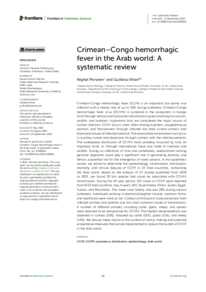وثيقة
Crimean–congo hemorrhagic fever in the Arab world : a systematic review.
المعرف
DOI: 10.3389/fvets.2022.938601
المصدر
Frontiers in Veterinary Science. v. 9, 938601
المساهمون
Khan, Gulfaraz., مؤلف
الدولة
Switzerland
الناشر
Frontiers Media S.A.
ميلادي
2022-09-13
اللغة
الأنجليزية
الملخص الإنجليزي
Crimean-Congo hemorrhagic fever (CCHF) is an important tick-borne viral infection with a fatality rate of up to 50% during outbreaks. Crimean-Congo hemorrhagic fever virus (CCHFV) is sustained in the ecosystem in benign form through vertical and horizontal transmission cycles involving tick vectors, wildlife, and livestock. Hyalomma ticks are considered the major source of human infection. CCHF occurs most often among butchers, slaughterhouse workers, and farmworkers through infected tick bites or/and contact with blood and tissues of infected livestock. The nosocomial transmission can occur in auxiliary nurses and physicians through contact with the infected patients. The widespread distribution of CCHFV most probably occurred by ticks on migratory birds, or through international travel and trade of livestock and wildlife. During co-infections of ticks and vertebrates, reassortment among genome segments could play a significant role in generating diversity, and hence, a potential risk for the emergence of novel variants. In this systematic review, we aimed to determine the epidemiology, transmission, distribution, mortality, and clinical features of CCHF in 22 Arab countries, comprising the Arab world. Based on the analysis of 57 studies published from 1978 to 2021, we found 20 tick species that could be associated with CCHFV transmission. During the 43-year period, 321 cases of CCHF were reported from 9/22 Arab countries, Iraq, Kuwait, UAE, Saudi Arabia, Oman, Sudan, Egypt, Tunisia, and Mauritania. The mean case fatality rate was 29% during various outbreaks. Individuals working in abattoirs/slaughter houses, livestock farms, and healthcare were most at risk. Contact with blood or body secretions from infected animals and patients was the most common mode of transmission. A number of different animals, including cattle, goats, sheep, and camels were reported to be seropositive for CCHFV. The highest seroprevalence was observed in camels (29%), followed by cattle (21%), goats (15%), and sheep (14%). We discuss these results in the context of policy-making and potential preventative measures that can be implemented to reduce the burden of CCHF in the Arab world.
ISSN
2297-1769
قالب العنصر
مقالات الدوريات

